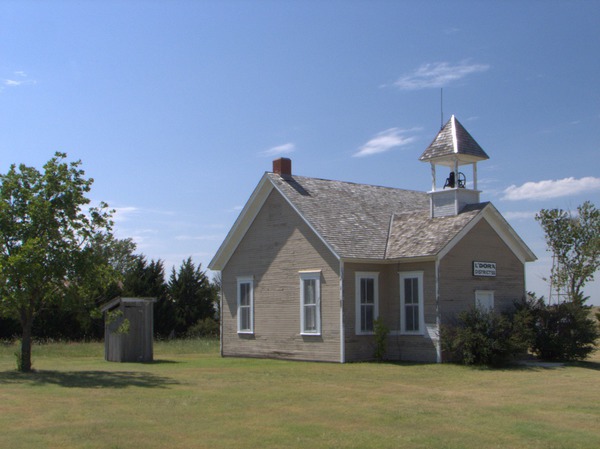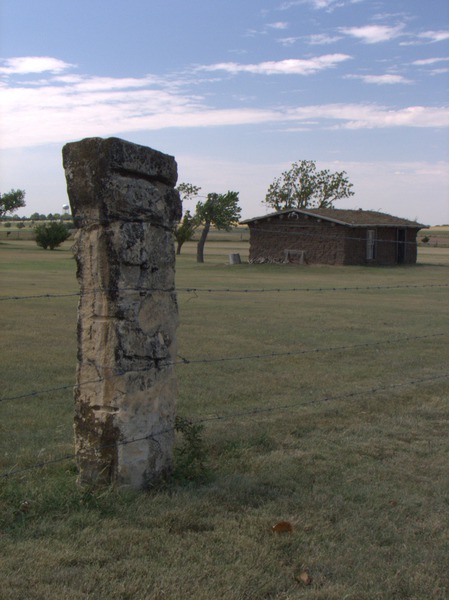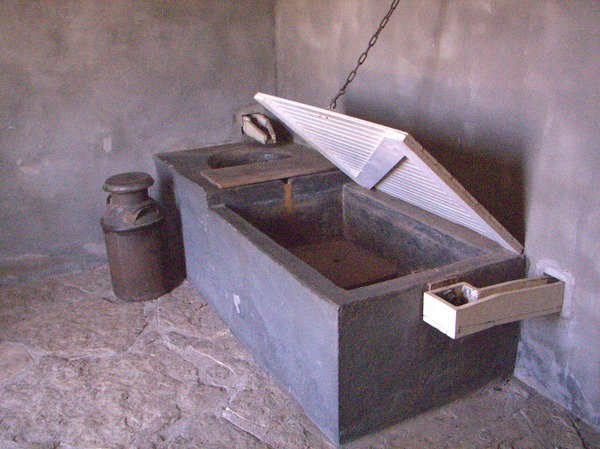Santa Fe Trail Center

L'Dora Schoolhouse -- This 1906 building was moved from Frizell, KS. The TV show Gunsmoke was set in Dodge City, KS, in the late 1880s. It ran from 1955 to 1975 and was the U.S. market's longest-running prime-time live-action drama (Wikipedia, Gunsmoke). Milburn Stone played Doc Adams during the whole run. His family lived for a time in Frizell, and he went to school in this building. (Fri 04 Sep 2015 12:56PM, Fullsize 282KB, Map) |
Frizell, KS, is a ghost town near the site of Fort Larned. It was named for the cattleman who owned the site. The school building was used until 1966. In 1970, it was moved to the Santa Fe Trail Center a few miles away (Bickel).

Soddy and Stone Fence Post -- Timber is scarce in Kansas. Nowadays one can run down to the nearest hardware and buy imported boards, but, during the heyday of the Santa Fe Trail, homesteaders usually made do with indigenous materials that were more affordable. This is a reproduction of a soddy, a shack built of turf skived off the prairie and stacked for walls. It may be seen at the Santa Fe Trail Center near Larned, KS. Wooden fence posts were few and far between, too. Where necessary, farmers substituted blocks of roughly quarried stone. (Fri 04 Sep 2015 12:27PM, Fullsize 293KB, Map) |
Here is a soddy, a home with earthen walls. There are a few authentic examples still standing throughout the Midwest. They tend to collapse because there is no framework. This is a reproduction. Soddies were stopgap shelters for young pioneer couples just getting started who couldn't wait a few seasons until they could afford something better. The owners usually put little effort into upkeep.

Milk Cooler -- Here is a well-insulated room with a floor below ground level. Outside, a windmill continuously pumps cool groundwater through a tank inside. Milk cans are immersed in the tank to cool the warm milk fresh from the cows before it goes sour and curdles, which works fine so long as the wind is blowing, which it mostly always does, I guess. Anyway, it was blowing well enough while I was there, but the windmill's brake was set. Probably, they don't like to have a mudhole outside, and they didn't have any fresh milk, either. I don't know whether it was customary to let the water run all day or not. I imagine that the oldtimers let it run long enough to bring the temperature of the milk down to the temperature of the groundwater and then set the brake. (Fri 04 Sep 2015 12:46PM, Fullsize 659KB, Map) |
The Santa Fe Trail Center contains an example of a well house for storing food, which in any other part of the world would be refrigerated by spring water. Here, such structures were cooled by well water.
It's difficult to see that the tank has a stepped floor inside. The lower step nearer the camera is deep. The milk can sitting on the floor outside will fit inside with the tank lid down. The higher step nearer the well-water inlet was used for shorter containers of foodstuff such as crocks of butter that sat immersed with lips above the waterline.
The floorspace around the tank provided room for temporary storage of other items, such as produce and canned goods, that were better kept out of hot weather and freezing weather.